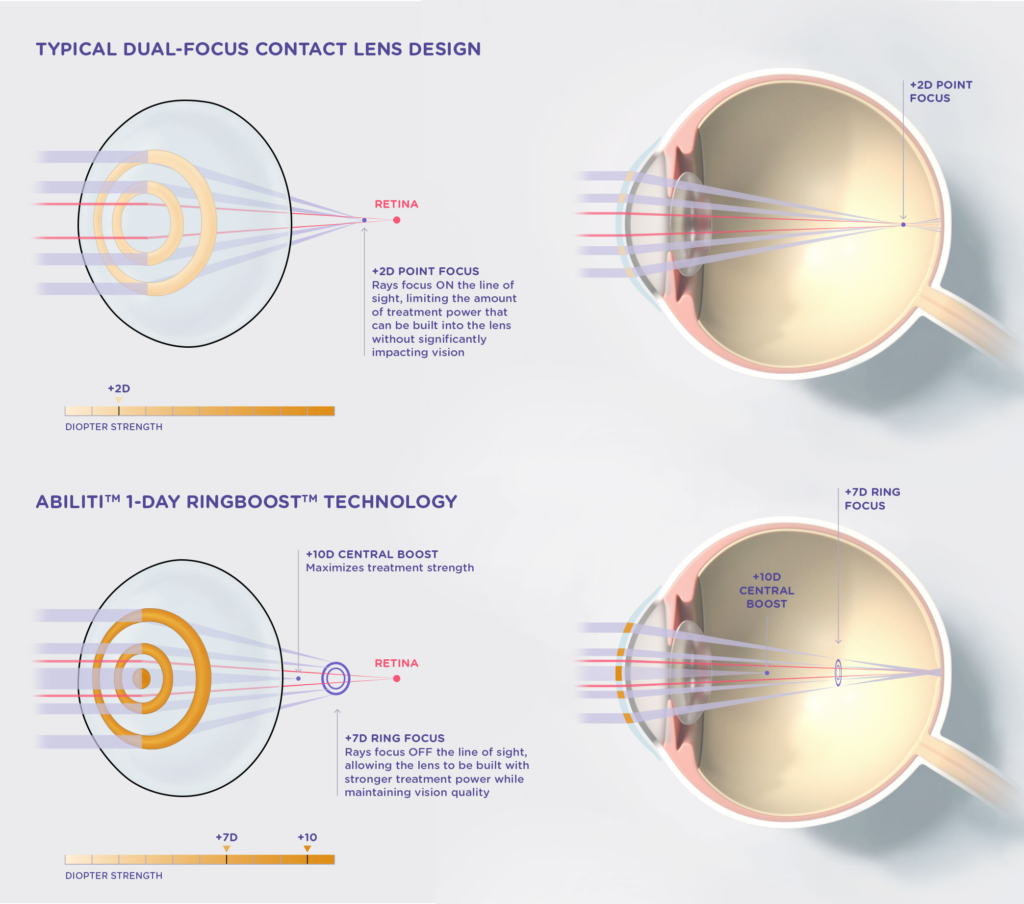The Myopia Epidemic has become virtually impossible to ignore. By 2050, approximately half of the world’s total population (5 billion) will have some level of myopia and 938 million people will be affected by high myopia.
High Myopia is defined as > -5D prescription. Even when appropriate spectacle correction is provided, the condition continues to place your child at a higher risk of sight-threatening diseases, including Glaucoma, Cataract, Retinal tears, Maculopathy etc
Currently the four myopia management strategies widely adapted in clinic are topical low-dose atropine, orthokeratology, dual focus soft contact lenses/center-distance multifocal contact lenses, and in some cases, bifocal or multifocal glasses.
Myopia control is a long term commitment. Once initiated, it is most effective if it is not discontinued until stable vision is achieved. Additionally, it is most effective the earlier the therapy is initiated.
Low-dose Atropine
The use of atropine in slowing down the progression of myopia was first reported in the 19 th century. The effectiveness of atropine for myopia control is higher than any other form of treatment currently available. Then why has the use of Atropine not become widespread from myopia progression?
The answer is the side effects of the medication. The commercially available concentration for atropine is 1.0%. At this concentration, this medication causes blurred near vision, pupil dilation and significant light sensitivity.
It has also been known to cause systemic side effects in rare instances which include but are not limited to increased heart rate, flushing of the skin, dry mouth and confusion. The concentration of Atropine is determined based on history of myopic progression, family history, patient health, iris colour and other factors.
As the patients are closely monitored, therapy may change according to how the visual system responds. Therapy should be continued for several years to reap the maximal benefit of myopia progression control.
Dual Focus Soft Contact Lenses
In typical dual focus soft contact lenses that are utilized for myopia management, the focal point generated for slowing eye growth is on the line of sight, which is seen to limit how strong the treatment power can be before the patient will have significant visual disturbance.
Abiliti™ 1-day lenses are a revolutionary innovation specifically targeted and designed for slowing the progression of myopia in children who are 7 to 12 years old at the start of treatment.
Johnson & Johnson Vision has developed this specialized optical design with novel RingBoost™ technology, in which the light passing through the outer treatment zones is focused in front of the retina but off the line of sight. This revolutionary technology is designed to break the interdependence between efficacy for slowing the progression of myopia and vision quality, seen as a limitation of dual focus and traditional multifocal lenses used for myopia management.
This means Abiliti™ 1-Day lenses can provide strong myopia treatment while maintaining vision quality. Typical multifocal or dual-focus lenses utilized for myopia management provide treatment power of no more than +3D along the line of sight, whereas Abiliti™ 1-Day lenses with RingBoost™ technology provide treatment power with a +7D ring focus and a +10D central boost.The unique optical properties of RingBoost™ technology are directly linked to the potential to slow the progression of myopia. In fact, in as little as 6 months, Abiliti™ 1-Day reduced axial elongation by 0.105mm on average. Generally speaking, 0.18mm corresponds to approximately 0.5D of myopia.

Miyosmart & SightGlass Vision Specialized Glasses
Up until 2010, the only options available to control myopia with spectacle-based strategies were progressive addition or bifocal spectacles. From 2010 onward, there was a shift toward developing and testing myopia management devices that altered peripheral retinal defocus based on landmark studies that found that peripheral retina had a significant role in emmetropisation and refractive error development. These strategies were based on inducing relative myopic defocus or reducing relative hyperopic defocus at the retinal periphery.
A recent new entrant, the D.I.M.S. or Defocus Incorporated Multiple Segments spectacle lenses (MiyoSmart by HOYA) reportedly slow myopia by 52 % (spherical equivalent) and axial length by 62 %compared to single vision spectacles. The D.I.M.S. spectacle lens has around 400 multiple segments of plus powered lenslets (+3.50D) in the mid-peripheral portion of the spectacle lens surrounding a clear central zone for distance refractive correction. Each segment is approximately 1mm in diameter. The multiple segments induce myopic defocus in front and at the retina periphery while simultaneously providing clear central vision.

Additionally, this decade also saw a new myopia management technology offering from SightGlass Vision, Inc., through contrast reduction.This novel spectacle lens design (SightGlass Vision D.O.T. lenses) incorporating “Light diffusion technology” has a clear central aperture surrounded by multiple dots that reduce the peripheral retinal contrast by at least one-third to half (30 percent to 60 percent) compared to central or on-axis contrast. The test lenses demonstrated reasonable myopia control with slowing of myopia progression by 59 % and 74 %(spherical equivalent) and reduction in axial length elongation by 33 % and 50 %.This technology is based on the hypothesis that high contrast signals at retinal photoreceptors induce the eye to grow and low contrast induce the eye to slow the axial growth.

